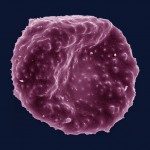Lien vers Pubmed [PMID] – 7957750
Exp. Parasitol. 1994 Nov;79(3):279-91
The transport of the megadalton protein Pf332 was studied during the asexual bloodstage development of Plasmodium falciparum. Four mouse monoclonal antibodies, produced against a recombinant polypeptide derived from the Pf332 protein, were used to analyze the kinetics of synthesis, the subcellular location, and transport of this giant molecule to the erythrocyte membrane. After parasite invasion of a red blood cell, the Pf332 antigen is first detected in young trophozoites at the parasitophorous vacuole membrane or in the cytoplasm of the erythrocyte as large vesicle-like structures. The number of vesicles increases during maturation of the parasite and thus forms a rim-like immunofluorescence pattern between the erythrocyte membrane and the parasitophorous vacuole at very late stages. The various anti-Pf332 antibodies react with the surface of erythrocytes infected with very mature parasites (segmenter stage 42-46 hr postinvasion). Immunoelectron microscopic analysis shows that the Pf332 antigen is transported in association with Maurer’s clefts in the cytoplasm of the erythrocyte. This transport could be completely blocked by Brefeldin A, resulting in the accumulation of the antigen within the parasite. These data strongly suggest that the Pf332 antigen is exported to the erythrocyte cytoplasm via the classical Golgi secretory pathway.

